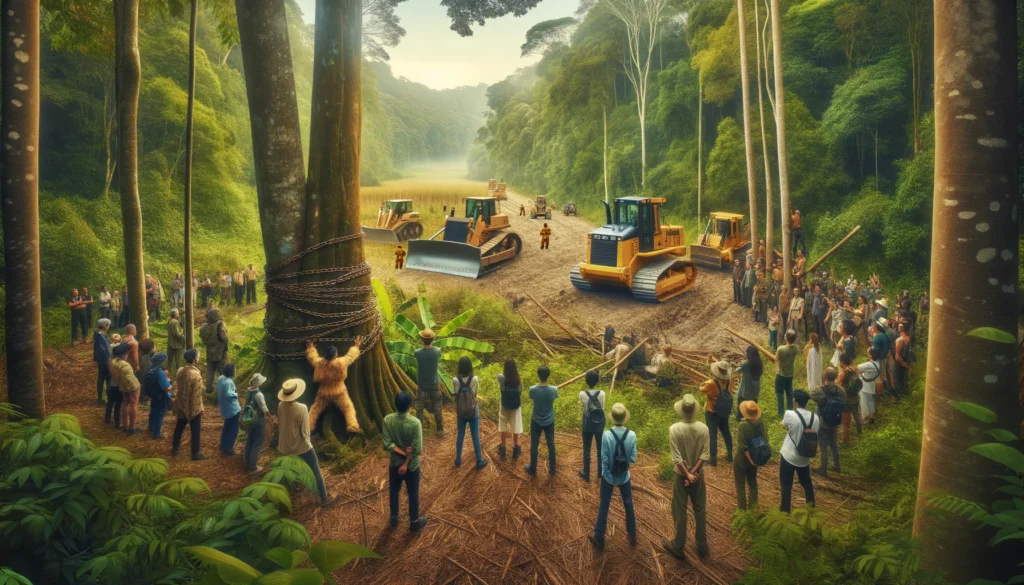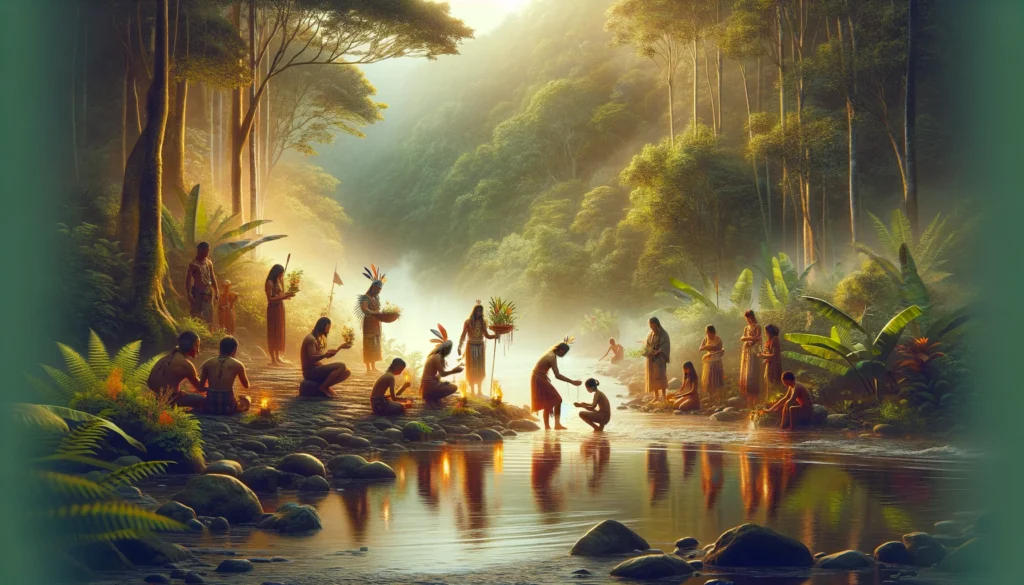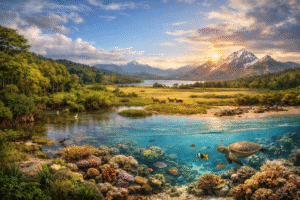Part IV: “Nature’s Rights: A New Era for Environmental Ethics”
Welcome to the fourth blog of our series where we delve into the transformative concept of the Rights of Nature. In this part of our series, we explore how this innovative idea is redefining our relationship with the Earth, granting legal standing and inherent value to natural entities like forests, rivers, and ecosystems.
We will journey through the philosophical shift this concept represents, its legal and ethical implications, and how it is being implemented across the globe. Join us as we uncover how the Rights of Nature are paving the way for a future where environmental protection, cultural respect, and sustainable development go hand in hand.
The Groundbreaking Concept of Nature’s Rights
The Rights of Nature is a revolutionary idea that challenges traditional views of nature as merely a resource for human use. Instead, it proposes that natural entities—like rivers, forests, and mountains—have their own rights, similar to human rights, acknowledging their intrinsic value and the essential roles they play in our world.

- Shift in Perspective: This concept marks a profound shift in how we perceive and interact with the natural world. It moves us from exploiting nature to recognizing it as a living partner with whom we share the planet. By granting legal rights to nature, we acknowledge that it has the right to exist, thrive, and evolve, independent of its utility to humans.
- Legal and Moral Recognition: The Rights of Nature involves not only legal changes but also a moral awakening. Legally, it requires adjustments to our judicial systems to recognize nature as a subject with standing in court. Morally, it calls for a deeper respect and ethical consideration for the natural world, recognizing that all life forms are interconnected and interdependent.
- Global Initiatives and Local Actions: Although the idea may seem radical, it has already taken root in various parts of the world. Countries like Ecuador and Bolivia have incorporated the Rights of Nature into their constitutions, setting legal precedents for others to follow. On a local level, communities are using this concept to protect their environments from harmful development projects and pollution.

- Inspiration from Indigenous Wisdom: The Rights of Nature also draws heavily from indigenous philosophies, which have long recognized the sentience and rights of natural entities. These traditional beliefs offer valuable insights into how legal systems can be reformed to incorporate a more holistic and ecocentric view of the world.
- A Path to Sustainable Coexistence: By recognizing the Rights of Nature, we pave the way for a more sustainable and equitable coexistence with the Earth. This approach promotes environmental stewardship, conservation, and restoration, ensuring that nature’s rights are protected and that human activities contribute positively to the health of the planet.
The Rights of Nature concept is groundbreaking because it fundamentally alters our legal and ethical frameworks, encouraging a more respectful and symbiotic relationship with the natural world.
Why the Rights of Nature Matter
Recognizing the Rights of Nature is crucial for a multitude of reasons, each underscoring the need to shift our perspective and policies toward a more sustainable and equitable relationship with the Earth.
- Strengthening Environmental Protection: By granting legal rights to nature, we can create stronger safeguards against exploitation and degradation. This legal standing empowers communities and environmental organizations to take legal action to protect natural entities, ensuring their preservation for future generations.

- Promoting Sustainable Development: The Rights of Nature framework encourages development practices that are in harmony with the Earth’s ecological systems. It ensures that economic activities do not compromise the ability of ecosystems to maintain their functions and support life, leading to more sustainable and resilient communities.
- Enhancing Social and Cultural Values: Many indigenous and local communities view natural elements like rivers, forests, and mountains as sacred. Recognizing these natural entities’ rights supports the preservation of cultural heritage and spiritual traditions, reinforcing the bond between people and the natural world.

- Encouraging Global and Local Stewardship: Acknowledging nature’s rights fosters a sense of responsibility at both individual and collective levels. It encourages people and governments to act as stewards of the environment, taking proactive steps to conserve and restore natural habitats and biodiversity.
- Addressing Climate Change and Environmental Injustice: The Rights of Nature can play a significant role in combating climate change and rectifying environmental injustices. By protecting ecosystems, we can enhance their resilience to climate impacts and ensure that the benefits of natural resources are shared more equitably among all communities.
In essence, the Rights of Nature matter because they represent a transformative approach to environmental governance, one that places the well-being of the Earth at the center of human activities. This shift is vital for ensuring the long-term health and sustainability of our planet and all its inhabitants.
Implementing Nature’s Rights
Putting the Rights of Nature into action involves several critical steps that ensure these rights are recognized and protected. Here’s how we can implement this revolutionary concept:
- Developing Legal Frameworks: The first step is to create laws that formally recognize the rights of natural entities. This involves drafting legislation that grants legal personhood to rivers, forests, and ecosystems, allowing them to have legal representation and rights similar to humans. These laws must outline the rights of nature to exist, regenerate, and evolve, and establish legal procedures for defending these rights in court.

- Community and Indigenous Leadership: Local communities, especially indigenous groups, are often at the forefront of the Rights of Nature movement. Their traditional knowledge and spiritual connection to the land are invaluable in shaping and advocating for these rights. Empowering these communities to lead the movement ensures that the implementation of nature’s rights is grounded in respect for the land and its original stewards.
- Education and Awareness: Raising awareness about the Rights of Nature is crucial for gaining public support and understanding. Educational programs, workshops, and media campaigns can help inform the public about the importance of these rights and how they contribute to environmental conservation and sustainability.
- Global Cooperation and Networks: The Rights of Nature is a global movement that requires collaboration across borders. Building international networks of activists, lawyers, and policymakers can help share successful strategies, legal precedents, and resources to advance the recognition of nature’s rights worldwide.
![]()
- Enforcement and Monitoring: Once laws are in place, effective mechanisms for enforcing and monitoring these rights are essential. This includes establishing bodies or organizations responsible for overseeing the protection of nature’s rights and creating systems for citizens to report violations and seek legal redress.
Implementing the Rights of Nature is about transforming our legal and societal frameworks to recognize and respect the intrinsic value of the natural world. Through these concerted efforts, we can foster a more harmonious and sustainable relationship with our planet.
Author’s Note
Thank you for exploring the intriguing concept of the Rights of Nature with us. As we reconsider our relationship with the natural world, this idea offers a path toward more respectful and sustainable interactions with our planet.
G.C., Ecosociosphere contributor.
References and Further Reading
- “The Rights of Nature: A Legal Revolution That Could Save the World” by David Boyd – Explores the legal movement to recognize nature’s rights.
- “Should Trees Have Standing? Law, Morality, and the Environment” by Christopher D. Stone – A seminal book that laid the groundwork for the Rights of Nature concept.
- “Wild Law: A Manifesto for Earth Justice” by Cormac Cullinan – Discusses laws and governance from an Earth-centric perspective, advocating for the recognition of nature’s rights.





Comments
Your point of view caught my eye and was very interesting. Thanks. I have a question for you.
Thank you for your sharing. I am worried that I lack creative ideas. It is your article that makes me full of hope. Thank you. But, I have a question, can you help me?
I don’t think the title of your article matches the content lol. Just kidding, mainly because I had some doubts after reading the article.
Can you be more specific about the content of your article? After reading it, I still have some doubts. Hope you can help me.